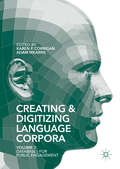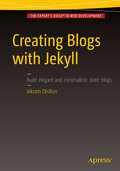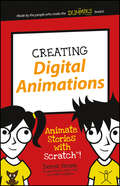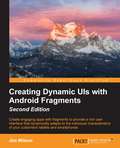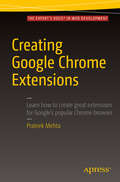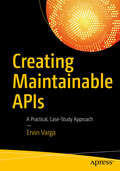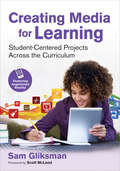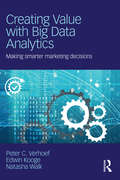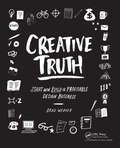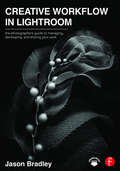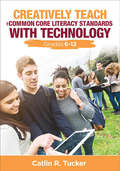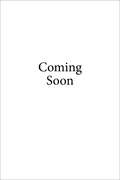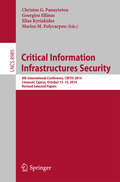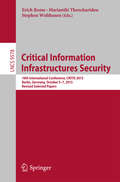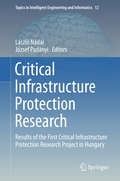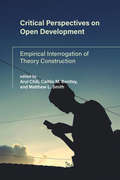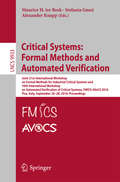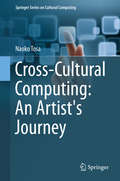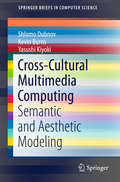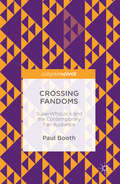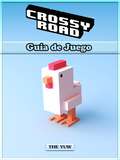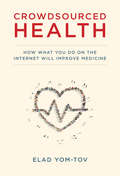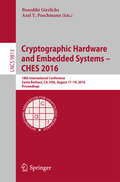- Table View
- List View
Creating and Digitizing Language Corpora: Volume 3: Databases for Public Engagement
by Karen P. Corrigan Adam MearnsThis book unites a range of approaches to the collection and digitization of diverse language corpora. Its specific focus is on best practices identified in the exploitation of these resources in landmark impact initiatives across different parts of the globe. The development of increasingly accessible digital corpora has coincided with improvements in the standards governing the collection, encoding and archiving of 'Big Data'. Less attention has been paid to the importance of developing standards for enriching and preserving other types of corpus data, such as that which captures the nuances of regional dialects, for example. This book takes these best practices another step forward by addressing innovative methods for enhancing and exploiting specialized corpora so that they become accessible to wider audiences beyond the academy.
Creating Blogs with Jekyll
by Vikram DhillonLearn to create your own blog using the Jekyll static site generator. You'll start with a simple template, add new features to it, automate any maintenance, attach social sharing, and begin writing. By the end of Creating Blogs with Jekyll, you will be able to create custom blogs with Jekyll, update the content with ease, and reach out to your readers with minimal effort. Because you've built your blog yourself, you'll know exactly how each component works, and you won't be dependent on an admin panel to maintain it. Creating Blogs with Jekyll equips you with the knowledge to create an elegantly designed blog and scale it to capture more readers. Recapture the magic of writing by creating great content and use an easy workflow in Jekyll to maintain it for blogging. Do new things and write about them in style with Jekyll. Takes you through building a fully functional blog from scratch using Jekyll Provides a fun way to work on a side-project and integrate cutting edge web technologies Teaches you how to update and maintain your awesome blog Jekyll is a simple, secure and very low maintenance blog engine that converts naturally written content in markdown into a beautiful and minimal blog. It allows you to focus on content creation and expressing yourself instead of spending all your time updating the plugins and maintaining the database. Jekyll does not rely on a database as a backend so your blog will be far more secure and reliable than any traditional blogging engines such as WordPress. We live in a day and age where short attention spans make it very difficult to expose a reader to interesting content. What better way to capture a reader's attention and retain viewers by captivating them by your own unique style and taste? Jekyll allows the content to shine with minimal distractions and a greater focus on the content and easy sharing of the content. What you'll learn Choose a base theme appropriate for your style and development Integrate various web technologies that will work well together and enhance your blog Automate social sharing components and comments workflow Make adjustments to themes, views and styles of blog posts Update any of the modular components of the blog and integrate new technologies Implementing Jekyll and deploying static websites for future projects Who this book is for Creating Blogs with Jekyll is for the developer who is ready to move beyond the complexities of maintaining a content management system by creating their own unique blog in their own style. It's for the project manager tired of spending all their time editing their blog on the admin panel and updating the content management system. Creating Blogs with Jekyll is an excellent choice for new developers to start blogging because of the simplicity of Jekyll's theming layer and writing workflow. It's an excellent choice for the web developer wanting to build their blog from scratch and expand their knowledge of higher level web technologies.
Creating Digital Animations
by Derek BreenThe easy way to start animating today! Creating Digital Animations is your ticket to learning animation! Learn how to animate your very own characters using Scratch--the free multimedia tool that lets you create interactive stories, games, and animations. Designed specifically for kids aged seven and up, this easy-to-follow, full-color guide introduces you to important game design concepts through three simple projects. Step-by-step instructions walk you through the four major phases of animation design, showing you how to turn your idea into a real animation with sound effects and more! You'll work just like the pros as you sketch out your main idea, add your own details, and develop a complete, workable character from scratch. If you're curious about coding, animation is the perfect place to start exploring. The Scratch platform doesn't require an actual programming language, but it gets you used to thinking like a programmer while you develop your very own animation. Short on rules but big on fun, this book is your friendly animation coach to get you started on the right foot. Use stick figures to design your characters' 'bones' Flesh out your design and animate movements Create scenes and background locations Add sound to take your animation to the next level Animation is fun! Building your own characters is exciting! And putting the finishing touches on your animation project shows you just how much you can learn while you play. Coding is a valuable skill that will serve you throughout school and beyond, and this book teaches you the basics in a way that leaves you hungry for more. Where will you take your new animation skills next? Creating Digital Animations takes you on the first steps of your journey to wherever you want to go!
Creating Dynamic UIs with Android Fragments - Second Edition
by Jim WilsonCreate engaging apps with fragments to provide a rich user interface that dynamically adapts to the individual characteristics of your customers' tablets and smartphones About This Book * From an eminent author comes a book that will help you create engaging apps that dynamically adapt to individual device characteristics * The only book that includes the latest fragment-oriented features and their role in Material design * This book provides code-intensive discussions and detailed examples that help you understand better and learn faster. Who This Book Is For This book is for developers with a basic understanding of Android programming who would like to improve the appearance and usability of their applications by creating a more interactive user experience and dynamically adaptive UIs; providing better support for tablets and smartphones in a single app; and reducing the complexity of managing app UIs. What You Will Learn * Learn the role and capabilities of fragments * Use Android Studio's fragment-oriented features * Create an app UI that works effectively on smartphones and tablets * Manage the creation and life cycle of fragments * Dynamically manage fragments using the FragmentTransaction class * Learn the application design for communicating between fragments * Leverage fragments when implementing applications that take advantage of the latest features of Material Design In Detail Today's users expect mobile apps to be dynamic and highly interactive, with rich navigation features. These same apps must look fantastic whether running on a medium-resolution smartphone or high-resolution tablet. Fragments provide the toolset we need to meet these user expectations by enabling us to build our applications out of adaptable components that take advantage of the rich capabilities of each individual device and automatically adapt to their differences. This book looks at the impact fragments have on Android UI design and their role in both simplifying many common UI challenges and in providing best practices for incorporating rich UI behaviors. We look closely at the roll of fragment transactions and how to work with the Android back stack. Leveraging this understanding, we explore several specialized fragment-related classes such as ListFragment and DialogFragment. We then go on to discuss how to implement rich navigation features such as swipe-based screen browsing, and the role of fragments when developing applications that take advantage of the latest aspects of Material Design. You will learn everything you need to provide dynamic, multi-screen UIs within a single activity, and the rich UI features demanded by today's mobile users. Style and approach A fast-paced learning guide that gives a hands-on, code-intensive approach with a focus on real-world applications.
Creating Google Chrome Extensions
by Prateek MehtaTransform your existing web applications into Google Chrome browser extensions and create brand new extensions that improve your own browsing experience and that of your users. This book shows you how Google Chrome browser extensions are extremely useful tools for enhancing the functionality of the Google Chrome web browser. For example, you can create extensions to summarize the current page you are reading, or to save all of the images in the page you are browsing. They have access to almost all of the features provided by the Google Chrome browser, and they can encapsulate such features in the form of a bundled application providing targeted functionality to users. Extensions also run in a sandboxed environment, making them secure - which is a huge plus in the modern web! The APIs provided by the Chrome Extensions framework help you empower web applications by coupling them with amazing features provided by the Google Chrome web browser, such as bookmarks, history, tabs, actions, storage, notifications, search, and a lot more - facilitating increased productivity on the Google Chrome web browser. What you'll learn Transform your web application ideas into Google Chrome extensions Choose the recommended components for creating your kind of extension Leverage the power of a Google Chrome browser by making use of the extensions API Showcase your existing web-development skills in a modern way by creating useful extensions. Who this book is for Creating Google Chrome Extensions is for existing web developers, experienced in creating simple web pages (using HTML, CSS, and JavaScript), to help them create browser extensions for Google Chrome. After understanding the examples and lessons in this book, you will be able to transform your existing web applications into Google Chrome browser extensions, as well as create brand new extensions.
Creating Maintainable APIs: A Practical, Case-Study Approach
by Ervin VargaBuild straightforward and maintainable APIs to create services that are usable and maintainable. Although this book focuses on distributed services, it also emphasizes how the core principles apply even to pure OOD and OOP constructs. The overall context of Creating Maintainable APIs is to classify the topics into four main areas: classes and interfaces, HTTP REST APIs, messaging APIs, and message payloads (XML, JSON and JSON API as well as Apache Avro). What You Will Learn Use object-oriented design constructs and their APIs Create and manage HTTP REST APIs Build and manage maintainable messaging APIs, including the use of Apache Kafka as a principal messaging hub Handle message payloads via JSON Who This Book Is For Any level software engineers and very experienced programmers.
Creating Media for Learning: Student-Centered Projects Across the Curriculum
by Sam GliksmanHelp Students Show Learning Through Media Creation Education hinges on effective communication. This book demonstrates how media has become a core component of modern communication and highlights the need to incorporate student-centered media projects throughout the curriculum. Self-expression with media will enhance the learning process and allow students to creatively demonstrate their knowledge. The strategies and tactics these pages offer equip educators to make their students enthusiastic experts at producing dynamic media projects. Content includes: The how, why, and when of prompting students to create their own media across subjects and grade levels. Keys to mastery of media formats from simple photography to eBooks to complex animations. Detailed descriptions of student projects that utilize different media. The benefits of media sharing, and how to do it responsibly. The innovative use of Augmented Reality, so readers can activate a video on the book’s printed pages with their mobile devices. Across all disciplines, mastery of media creation is central to the success of current and next generation students. Educators who implement this book’s ideas will be amazed by the resultant increase in student engagement and depth of learning. "What a thoughtful collection of student-created products. This book highlights a variety of multimedia projects, offers a multitude of best practices and practical implementation tips, and is sure to empower teachers to help students find their voice." Lisa Johnson, Eanes ISD Ed Tech @TechChef4u
Creating Media for Learning: Student-Centered Projects Across the Curriculum
by Sam GliksmanHelp Students Show Learning Through Media Creation Education hinges on effective communication. This book demonstrates how media has become a core component of modern communication and highlights the need to incorporate student-centered media projects throughout the curriculum. Self-expression with media will enhance the learning process and allow students to creatively demonstrate their knowledge. The strategies and tactics these pages offer equip educators to make their students enthusiastic experts at producing dynamic media projects. Content includes: The how, why, and when of prompting students to create their own media across subjects and grade levels. Keys to mastery of media formats from simple photography to eBooks to complex animations. Detailed descriptions of student projects that utilize different media. The benefits of media sharing, and how to do it responsibly. The innovative use of Augmented Reality, so readers can activate a video on the book’s printed pages with their mobile devices. Across all disciplines, mastery of media creation is central to the success of current and next generation students. Educators who implement this book’s ideas will be amazed by the resultant increase in student engagement and depth of learning. "What a thoughtful collection of student-created products. This book highlights a variety of multimedia projects, offers a multitude of best practices and practical implementation tips, and is sure to empower teachers to help students find their voice." Lisa Johnson, Eanes ISD Ed Tech @TechChef4u
Creating Value with Big Data Analytics: Making Smarter Marketing Decisions
by Peter C. Verhoef Edwin Kooge Natasha WalkOur newly digital world is generating an almost unimaginable amount of data about all of us. Such a vast amount of data is useless without plans and strategies that are designed to cope with its size and complexity, and which enable organisations to leverage the information to create value. This book is a refreshingly practical, yet theoretically sound roadmap to leveraging big data and analytics. Creating Value with Big Data Analytics provides a nuanced view of big data development, arguing that big data in itself is not a revolution but an evolution of the increasing availability of data that has been observed in recent times. Building on the authors’ extensive academic and practical knowledge, this book aims to provide managers and analysts with strategic directions and practical analytical solutions on how to create value from existing and new big data. By tying data and analytics to specific goals and processes for implementation, this is a much-needed book that will be essential reading for students and specialists of data analytics, marketing research, and customer relationship management.
Creative Truth: Start & Build a Profitable Design Business
by Brad WeaverCreative Truth is your playbook for starting, building, and enjoying a profitable design business. Whether you’re a solo freelancer working from home or a small group of creative entrepreneurs ready to get to the next level, this is your roadmap to success. You’re the CEO, CFO, CTO, Secretary, Janitor, Office Manager, and everything in between. Finding a balance between running the business and doing great creative work is a constant struggle. From learning how to price your work and manage your time, to setting up your business and defining your market, Brad Weaver covers everything designers need to know to run a studio without losing heart. <P><P>Highlights: <li>Real numbers, real tools, and best practices in a toolkit that you can start using immediately in your business. <li>A companion website that offers up-to-date resources, articles, tools, and discussions, allowing readers to continue learning as they grow. <li>Practical tips for getting clients, being more profitable, building your network, managing your operations, getting things done, hiring help, managing contractors, and finding joy along the way.
Creative Workflow in Lightroom: The photographer’s guide to managing, developing, and sharing your work
by Jason BradleyAdobe’s Lightroom has emerged as a must-have software due to its powerful editing tools and time saving organizational capabilities but how you establish a personalized, creative workflow that optimizes this technology, your time, and your art eludes most photographers. Jason Bradley, award-winning photographer and Lightroom pro, shares the answers to these questions in this practical and easy to follow guide that taps into the "how" and the "why" of a professional photographer’s creative workflow in Lightroom. Bradley will show you how all workflows can be simplified into three steps: establishing, managing, and rendering the file, alongside stunning photographs and explanations from his own experiences. This book will not only teach you how to work within Lightroom but, ultimately, how to make Lightroom work for you.
Creatively Teach the Common Core Literacy Standards With Technology: Grades 6-12 (Corwin Teaching Essentials)
by Catlin R. TuckerLet technology pave the way to Common Core success. Engage your students by delving into the Common Core ELA standards with the tools they use the most. As you explore the creative road to academic success, with the Common Core ELA and literacy standards—you will turn your classroom into a student-centered learning environment that fosters collaboration, individualizes instruction, and cultivates technological literacy. Features include: Specific recommendations for free apps and tech tools that support the Common Core Step-by-step guidelines to breaking down standards by grade and subject Teacher-tested, research-supported lesson ideas and strategies Replicable resources, including prewriting activities and writing templates Real-life examples
Creatively Teach the Common Core Literacy Standards With Technology: Grades 6-12 (Corwin Teaching Essentials)
by Catlin R. TuckerLet technology pave the way to Common Core success. Engage your students by delving into the Common Core ELA standards with the tools they use the most. As you explore the creative road to academic success, with the Common Core ELA and literacy standards—you will turn your classroom into a student-centered learning environment that fosters collaboration, individualizes instruction, and cultivates technological literacy. Features include: Specific recommendations for free apps and tech tools that support the Common Core Step-by-step guidelines to breaking down standards by grade and subject Teacher-tested, research-supported lesson ideas and strategies Replicable resources, including prewriting activities and writing templates Real-life examples
Creeper Invasion: An Unofficial Minetrapped Adventure, #5 (The Unofficial Minetrapped Adventure #5)
by Winter MorganThe three friends trapped in their Minecraft game have never been closer to escaping the Overworld, and they can’t wait to return home after being trapped on the server for so long.But then a vicious horde of creepers attacks, delaying their escape. Soon the gang learns that there’s a new villain behind the attack: a griefer so twisted that he’d rather stay trapped in the Overworld than live a mundane life in the real world-and he has no qualms about keeping every other player trapped on the server with him. Can the friends and their new allies defeat the creepers, conquer their new enemy, and finally return home?Friends and enemies unite against evil in this exhilarating fifth book in bestselling author Winter Morgan’s Unofficial Minetrapped Adventure series.Sky Pony Press, with our Good Books, Racehorse and Arcade imprints, is proud to publish a broad range of books for young readers-picture books for small children, chapter books, books for middle grade readers, and novels for young adults. Our list includes bestsellers for children who love to play Minecraft; stories told with LEGO bricks; books that teach lessons about tolerance, patience, and the environment, and much more. While not every title we publish becomes a New York Times bestseller or a national bestseller, we are committed to books on subjects that are sometimes overlooked and to authors whose work might not otherwise find a home.
Critical Information Infrastructures Security: 9th International Conference, CRITIS 2014, Limassol, Cyprus, October 13-15, 2014, Revised Selected Papers (Lecture Notes in Computer Science #8985)
by Georgios Ellinas Elias Kyriakides Christos G. Panayiotou Marios M. PolycarpouThis bookconstitutes revised selected papers from the 9th International Conference onCritical Information Infrastructures Security, CRITIS 2014, held in Limassol,Cyprus, in October 2014. The 20 fulland 19 short papers presented in this volume were carefully reviewed andselected from 74 submissions. They are organized in topical sections named:cyber-physical systems and sensor networks; security of water systems; powerand energy system security; security and recovery policies, cyber security; andsecurity tools and protocols.
Critical Information Infrastructures Security: 10th International Conference, CRITIS 2015, Berlin, Germany, October 5-7, 2015, Revised Selected Papers (Lecture Notes in Computer Science #9578)
by Marianthi Theocharidou Erich Rome Stephen WolthusenThis book constitutesrevised selected papers from the 10th International Conference on CriticalInformation Infrastructures Security, CRITIS 2015, held in Berlin, Germany, inOctober 2015. The 18 full and 6short papers presented in this volume were carefully reviewed and selected from54 submissions. They are organized in topical sections named: critical informationinfrastructure protection; critical infrastructure resilience assessment; emergencymanagement: critical infrastructure preparedness; modelling, simulation and analysisapproaches; electric grid protection and resilience; and CIPRNet young CRITIS awardcandidate papers.
Critical Infrastructure Protection Research: Results of the First Critical Infrastructure Protection Research Project in Hungary (Topics in Intelligent Engineering and Informatics #12)
by László Nádai József PadányiThis bookpresents recent research in the recognition of vulnerabilities of nationalsystems and assets which gained special attention for the CriticalInfrastructures in the last two decades. The book concentrates on R&Dactivities in the relation of Critical Infrastructures focusing on enhancingthe performance of services as well as the level of security. The objectives ofthe book are based on a project entitled "Critical InfrastructureProtection Researches" (TÁMOP-4. 2. 1. B-11/2/KMR-2011-0001) whichconcentrated on innovative UAV solutions, robotics, cybersecurity, surfaceengineering, and mechatornics and technologies providing safe operations ofessential assets. This report is summarizing the methodologies and effortstaken to fulfill the goals defined. The project has been performed by theconsortium of the Óbuda University and the National University of PublicService.
Critical Perspectives on Open Development: Empirical Interrogation of Theory Construction (International Development Research Centre)
by Arul Chib, Caitlin M. Bentley, and Matthew L. SmithTheoretical and empirical analyses of whether open innovations in international development instrumentally advantages poor and marginalized populations.Over the last ten years, "open" innovations--the sharing of information without access restrictions or cost--have emerged within international development. But do these practices instrumentally advantage poor and marginalized populations? This book examines whether, for whom, and under what circumstances the free, networked, public sharing of information and communication resources contributes (or not) towards a process of positive social transformation. The contributors offer both theoretical and empirical analyses that cover a broad range of applications, emphasizing the underlying aspects of open innovations that are shared across contexts and domains.
Critical Systems: Joint 21st International Workshop on Formal Methods for Industrial Critical Systems and 16th International Workshop on Automated Verification of Critical Systems, FMICS-AVoCS 2016, Pisa, Italy, September 26-28, 2016, Proceedings (Lecture Notes in Computer Science #9933)
by Stefania Gnesi Alexander Knapp Maurice H. ter BeekThis book constitutes the refereed proceedings of the Joint 21st International Workshop on Formal Methods for Industrial Critical Systems and the 16th International Workshop on Automated Verification of Critical Systems, FMICS-AVoCS 2016, held in Pisa, Italy, in September 2016. The 11 full papers and 4 short papers presented together with one invited talk were carefully reviewed and selected from 24 submissions. They are organized in the following sections: automated verification techniques; model-based system analysis; and applications and case studies.
Cross-Cultural Computing: An Artist's Journey (Springer Series on Cultural Computing)
by Naoko TosaThis exciting new book explores the relationship between cultural traditions and computers, looking at how people from very different cultures and backgrounds communicate and how the use of information technologies can support and enhance these dialogues. Historically we developed our understanding of other cultures through traditional means (museums, printed literature, etc. ) but the advent of information technologies has allowed us access to a plethora of material. Tosa asks the question "Can we understand other cultures using computers as media to supplement thinking and memorization?" Starting with a survey of art and technology, moving into the area of culture and technology, the book culminates with a vision of a new world based on an understanding of these relationships, allowing cultural creators and viewers the opportunity to reach a better and more profound understanding of the role information technology will play going forward.
Cross-Cultural Multimedia Computing: Semantic and Aesthetic Modeling (SpringerBriefs in Computer Science)
by Shlomo Dubnov Kevin Burns Yasushi KiyokiThe ability to communicate cultural codes in multimedia depends on their meaning and beauty, as perceived by different audiences around the globe. In this book, the ongoing research on computational modeling of visual, musical and textual contents is described in terms of identifying and mapping their semantic representations across different cultures. The underlying psychology of sense-making is quantified through analysis of aesthetics in terms of organizational and structural aspects of the contents that influence an audience's formation of expectations for future signals, violations of these expectations, and explanations of their meaning. Complexity-accuracy tradeoffs in sound representation are further used to develop new computational methods that capture poietic and aesthetic aspects in music communication. Experimental studies are reported that try to characterize preferences for complexity in abstract, classical and traditional art and music across samples of Western and Far Eastern cultures. These experiments illustrate how aesthetics can be computed in terms of semantic and information measures, highlighting commonalities and uncovering differences in aesthetic preferences across cultures and individuals.
Crossing Fandoms: SuperWhoLock and the Contemporary Fan Audience
by Paul BoothThis book examines the fan-created combination of Doctor Who, Sherlock, and Supernatural as a uniquely digital fan experience, and as a metaphor for ongoing scholarship into contemporary fandom. What do you get when you cross the cult shows Doctor Who, Supernatural, and Sherlock? In this book, Paul Booth explores the fan-created crossover universe known as SuperWhoLock--a universe where Sherlock Holmes and Dean Winchester work together to fight monsters like the Daleks and the Weeping Angels; a world where John Watson is friends with Amy Pond; a space where the unique brands of fandom interact. Booth argues that SuperWhoLock represents more than just those three shows--it is a way of doing fandom. Through interviews with fans and analysis of fan texts, Crossing Fandoms: SuperWhoLock and the Contemporary Fan Audience also demonstrates how fan studies in the digital age can evolve to take into account changing fan activities and texts.
Crossy Road Guía de Juego
by António José Leite da Silva Correia Hiddenstuff EntertainmentComrpando este guia de jogo avançado e detalhado, eis o que irás obter: - Dicas profissionais e estratégias. - Cheats e Hacks. - Segredos, dicas, cheats, desbloqueadores e truques usados pelos jogadores Pro! - Como obter dinheiro e moedas em abundância. - E MUITO MAIS! Todas as versões deste guia têm imagens que te ajudam a compreender melhor o jogo. Não há um guia tão compreensivo e avançado como este. Estarás satisfeito com este guia e irás beneficiar muito mais quando comparado com outros guias que andam por aí. Compra agora e derrota os teus adversários. Torna-te hoje um jogador Pro!
Crowdsourced Health: How What You Do on the Internet Will Improve Medicine
by Elad Yom-TovHow data from our health-related Internet searches can lead to discoveries about diseases and symptoms and help patients deal with diagnoses. Most of us have gone online to search for information about health. What are the symptoms of a migraine? How effective is this drug? Where can I find more resources for cancer patients? Could I have an STD? Am I fat? A Pew survey reports more than 80 percent of American Internet users have logged on to ask questions like these. But what if the digital traces left by our searches could show doctors and medical researchers something new and interesting? What if the data generated by our searches could reveal information about health that would be difficult to gather in other ways? In this book, Elad Yom-Tov argues that Internet data could change the way medical research is done, supplementing traditional tools to provide insights not otherwise available. He describes how studies of Internet searches have, among other things, already helped researchers track to side effects of prescription drugs, to understand the information needs of cancer patients and their families, and to recognize some of the causes of anorexia. Yom-Tov shows that the information collected can benefit humanity without sacrificing individual privacy. He explains why people go to the Internet with health questions; for one thing, it seems to be a safe place to ask anonymously about such matters as obesity, sex, and pregnancy. He describes in detrimental effects of “pro-anorexia” online content; tells how computer scientists can scour search engine data to improve public health by, for example, identifying risk factors for disease and centers of contagion; and tells how analyses of how people deal with upsetting diagnoses help doctors to treat patients and patients to understand their conditions.
Cryptographic Hardware and Embedded Systems - CHES 2016: 18th International Conference, Santa Barbara, CA, USA, August 17-19, 2016, Proceedings (Lecture Notes in Computer Science #9813)
by Axel Y. Poschmann Benedikt GierlichsThis book constitutes the proceedings of the 18th International Conference on Cryptographic Hardware and Embedded Systems, CHES 2016, held in Santa Barbara, CA, USA, in August 2016. The 30 full papers presented in this volume were carefully reviewed and selected from 148 submissions. They were organized in topical sections named: side channel analysis; automotive security; invasive attacks; side channel countermeasures; new directions; software implementations; cache attacks; physical unclonable functions; hardware implementations; and fault attacks.
